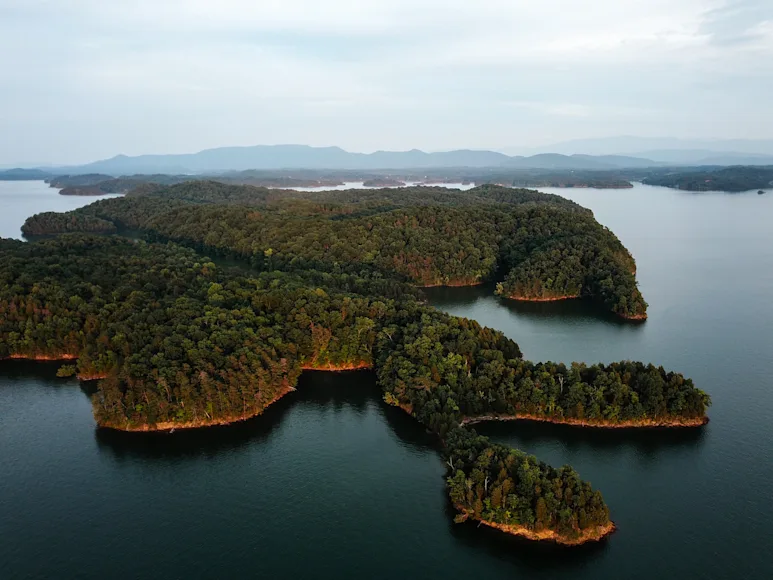This story was done in partnership with Visit Jefferson County Tourism.
Every red-blooded American angler can rattle off a predictable list of must-visit fishing destinations—towns like Traverse City, Michigan; Missoula, Montana; or Montauk, New York. One place that’s loaded with fish but never ends up on such lists is Jefferson County, Tennessee—30 miles east of Knoxville, in the foothills of the Great Smoky Mountains. If you’re an angler who’s serious about catching a mess of bass, crappie, or trout, Jefferson County’s low exposure means you’ll have few anglers to share the water with when you go.
But if that’s not reason enough for you to make the trip, allow us to make the case:

1) You Can Fish Two Superb Bass Lakes—Just 10 Minutes Apart
President Franklin D. Roosevelt did a lot of good stuff: created Social Security, led the Allies to victory in the Second World War, etc., but one of his biggest, most underappreciated accomplishments (in our fish-addicted minds anyway) is that he turned the South into a sportsman’s paradise. And he did it with the Tennessee Valley Authority (TVA). Beginning in the 1930s, TVA, a cornerstone of the New Deal, built or acquired nearly 50 dams throughout the Southeast, creating vast mountain reservoirs behind the impoundments. Two of the most picturesque TVA reservoirs lie within Jefferson County—Douglas Lake and Cherokee Lake.
Douglas Lake, near the town of Dandridge, covers some 30,600 acres and has a well-earned reputation as a prime largemouth fishery—known for producing an abundance of 3- to 5-pound lunkers in its many murky backwater coves. And, while the bass are the primary appeal, the sweeping backdrop of the rolling, green Smoky Mountains adds much grandeur to the place. If you’re venturing out for the first time, the Dandridge Boat Ramp features, for our money, one of the best floating T-docks in the nation. Flat Creek and Nina Creek are both productive spots nearby that also boastpublic boat ramps. And if largemouth isn’t your thing, Douglas is loaded with crappie and sauger, a member of the perch family, similar to walleye. For a good shot at both, locals swear by jigs with a white fly over a chartreuse head and a medium minnow.

Cherokee Lake, about 15 minutes north, is roughly the same size as Douglas, but the former has a stronger, healthier population of smallmouths, which thrive in the lake’s extensive rock structure and relatively cool, clear water. The lower end of the lake near Cherokee Dam is dotted with islands, making it a particularly good spot to hook smallies; the bluff walls in the area also teem with bronze trophies. And if you somehow get your fill of smallies, you can access the Holston River at the Cherokee Dam and fish a prime trout tailwater. Much of the lower Holston is tricky to cover without a kayak or drift boat, owing to a limited number of public put-ins, but wading anglers can reach a choice stretch of shoals a short walk from the dam, where holdover rainbows are known to grow up to 20 inches. Locals swear by simple red worms, be it a fly or live bait.
2) You Can Catch Smoky Mountain Brook Trout—Without Staying in a Tourist Trap
Each year, somewhere north of 13 million people flock to East Tennessee to take in the ancient beauty of the southern Appalachians. Most visitors stay just outside the Great Smoky Mountains National Park, home to some of the last remaining stands of old-growth timber in the eastern United States. It was in the Smokies where, in 1904, Horace Kepart, one of Field & Stream’s most distinguished contributors and the author of the classic guide Camping and Woodcraft, left behind his life as a St. Louis librarian and sought out what he called a “Back of Beyond”—a remote, untouched wilderness far from modernity. The Park itself, which covers more than half a million acres of lush timberland, still fits that description. The problem is that Gatlinburg and Pigeon Forge, two of the main entrances, have in recent decades morphed from quiet vacation towns into tourist magnets. Which translates into migraine-inducing congestion.

By staying in Jefferson County, you can put a comfortable distance between yourself and the two cities’ constant gridlock and enter the Park through a less-congested route (e.g., the Greenbrier entrance). The opportunity to hook a Southern Appalachian brook trout, the sole native salmonid in the South, certainly warrants the drive. The luminous little fighters haunt tiny, crystalline pools, complicating any approach, and will spook at the first botched cast. So put in some practice with your 3-weight beforehand. But the difficulty of hooking a native brookie, along with the beauty of the deep backcountry glens they inhabit, makes netting one an almost mystical experience—a chance to encounter a holdover from the last ice age. You can find pockets of brookies in the streams that feed the Little Pigeon River, as well as in the upper reaches of the Little River; lower portions of the river outside the Park hold stocked rainbows if you’re after a heftier catch or want to use live bait, a no-go in the Park.
3) You Can (Probably) Get There Easily, and Enjoy Top-Notch Accommodations Right on the Water
There’s no debating that Jefferson County is far less congested and more remote than other areas around the Smokies. But that doesn’t mean it’s a gigantic pain to reach. It’s not. Jefferson County sits within a day’s drive of much of the Eastern United States, and Interstate 40, which runs east to west from North Carolina to southern California, cuts straight through the county, making for an easy, uncomplicated drive. Once you pull off at Exit 417, Douglas Lake is about 10 minutes one way, and Cherokee Lake is about 15 minutes the other.

Another plus: lodging. Many resorts just outside the Park—we’re trying to be polite here so we won’t name names—tend to have what can only be described as granny decor (think: floral pillows and tacky oil paintings). In Jefferson County, in contrast, you can stay at the Smoky Mountain Lakeside Resort and Marina, which overlooks Douglas Lake. The resort underwent a major renovation a few years ago, and, as a result, its mix of single rooms, cabins, and large lodges (which sleep up to 12) have a fresh, modern, distinctly ungranny vibe — plus wifi game rooms, hot tubs, fire pits, and easy access to the dock.
Food is the final selling point: when you’re in New York City or Chicago, eat pizza. When you’re in Buffalo, eat wings. And when you’re in the rural South on a fishing trip, eat ribs, fried catfish, mashed potatoes, and okra. The Millstone Restaurant & Country Store, in Dandridge, and Lisa’s Country Kitchen, in Jefferson City, are local favorites. For a celebratory night out after filling your cooler with slabs, grab a pint at the MadOx House, a watering hole in Jefferson City’s revitalized historic downtown. It serves locally sourced smash burgers and out of this world specialty pizzas, alongside a myriad of regional drafts. Mid-meal, after having such a fish-filled (and, dare we say, life-affirming?) trip to Jefferson County, you might even feel a tiny pang of sympathy for the poor saps trapped in Gatlinburg gridlock, fighting to get to the nearest dismal buffet, frustrated by their low-catch outings. They were so close to one of the country’s premium fishing spots, yet an entire angling world away.



